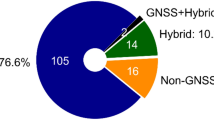Abstract
This paper proposes a global path planning for lunar rovers in polar regions under static and dynamic constraints. Prior to lunar mission launch, a specific mission path must be set for a lunar rover. The mission path is generated under uncertain information. Only lunar digital elevation model (DEM) and secondary parameters derived from DEM are available. The parameters can be divided into two categories: static parameters and dynamic parameters. Parameters such as DEM, slope, and roughness can be categorized into static parameters. Illumination and thermal inertia can be categorized into dynamic constraints. This paper introduces such parameters as constraints for path planning, by either giving weight to each parameters or suggesting a threshold for a dead zone. A* path planning method is used to implement such parameters as constraints. Simulations of path planning are shown.












Similar content being viewed by others
References
LaValle SM (2006) Planning algorithms. Cambridge University Press, Cambridge
Intelligent Robotics Group (2017) The Ames Stereo Pipline. NASA Ames Research Center, Mountain View
Mahtab A, Narender B (2003) Satellite derived digital elevation model and terrain parameters—generation, accuracy assessment and validation. J Indian Soc Remote Sens 31(1):19–24
Bussey D, Ben J, Spudis PD, Robinson MS (1999) “Illumination conditions at the lunar south pole. Geophys Res Lett 26(9):1187–1190
K Horai et al (1970) Thermal diffusivity, conductivity and thermal inertia of Apollo 11 lunar material. Geochimica et Cosmochimica Acta Supplement 1:2243
Bundick W, Green C, Brummer E (1967) The Lunar orbiter telecommunications systems. IEEE Trans Commun Technol 15(3):433–443
Soltani-Zarrin R, Jayasuriya S (2014) Constrained directions as a path planning algorithm for mobile robots under slip and actuator limitations. In: 2014 IEEE/RSJ international conference on intelligent robots and Systems, IEEE, pp 2395–2400
Ishigami G, Nagatani K, Yoshida K (2007) Path planning for planetary exploration rovers and its evaluation based on wheel slip dynamics. In: Proceedings 2007 IEEE international conference on robotics and automation, IEEE, pp 2361–2366
Sutoh M, Otsuki M, Wakabayashi S, Hoshino T, Hashimoto T (2015) The right path: comprehensive path planning for lunar exploration rovers. IEEE Robot Autom Mag 22(1):22–33
Seet BC, Liu G, Lee BS, Foh CH, Wong KJ, Lee KK (2004) A-STAR: A mobile ad hoc routing strategy for metropolis vehicular communications. In: International conference on research in networking, Springer, Berlin, Heidelberg, pp 989–999
Naumov V, Gross TR (2007) Connectivity-aware routing (CsAR) in vehicular ad-hoc networks. In: IEEE INFOCOM 2007-26th IEEE international conference on computer communications, IEEE, pp 1919–1927
Lee KC, Lee U, Gerla M (2010) Survey of routing protocols in vehicular ad hoc networks. Advances in vehicular ad-hoc networks: developments and challenges. IGI Global, Pennysylvania, pp 149–170
Leader MK et al (2014) Velocity of a rover as a function of slope of lunar terrain. Lunar and Planetary Science Conference, Vol 45
Garrick-Bethell I et al (2005) Areas of favorable illumination at the lunar poles calculated from topography. In: 36th Annual lunar and planetary science conference, Vol 36
Noda H et al (2008) Illumination conditions at the lunar polar regions by Kaguya(Selene) laser altimeter. Geophys Res Lett 35(24):L24203
Bryant S (2010) Lunar pole illumination and communications statistics computed from GSSR elevation data. SpaceOps 2010 Conference delivering on the dream hosted by NASA Marshall Space Flight Center and Organized by AIAA
Mazarico E, Neumann GA, Smith DE, Zuber MT, Torrence MH (2011) Illumination conditions of the lunar polar regions using LOLA topography. Icarus 211(2):1066–1081
Stewart AJ (1998) Fast horizon computation at all points of a terrain with visibility and shading applications. IEEE Trans Vis Comput Gr 4(1):82–93
Margot J-L et al (1999) Topography of the lunar poles from radar interferometry: A survey of cold trap locations. Science 284(5420):1658–1660
Nagy G (1994) Terrain visibility. Comput Graph 18(6):763–773
Williams JG, Boggs DH, Folkner WM (2008) Lunar orbit, physical librations and surface coordinates. Jet Propulsion Laboratory, Pasadena
Dozier J, Bruno J, Downey P (1981) A faster solution to the horizon problem. Comput Geosci 7(2):145–151
Pillot B, Muselli M, Poggi P, Haurant P, Dias JB (2016) Development and validation of a new efficient SRTM DEM-based horizon model combined with optimization and error prediction methods. Sol Energy 129:101–115
Acknowledgements
We would like to express our gratitude to professor Han-Lim Choi for his contribution in initial conceptualization of the proposed methodology.
Funding
This Research was prepared at the Korea Advanced Institute of Science and Technology (KAIST), Department of Aerospace Engineering under a research grant from the National Research Foundation of Korea (NRF-2016M1A3A3A02017919).
Author information
Authors and Affiliations
Corresponding author
Additional information
Publisher's Note
Springer Nature remains neutral with regard to jurisdictional claims in published maps and institutional affiliations.
Rights and permissions
About this article
Cite this article
Bai, J.H., Oh, YJ. Global Path Planning of Lunar Rover Under Static and Dynamic Constraints. Int. J. Aeronaut. Space Sci. 21, 1105–1113 (2020). https://doi.org/10.1007/s42405-020-00262-x
Received:
Revised:
Accepted:
Published:
Issue Date:
DOI: https://doi.org/10.1007/s42405-020-00262-x




